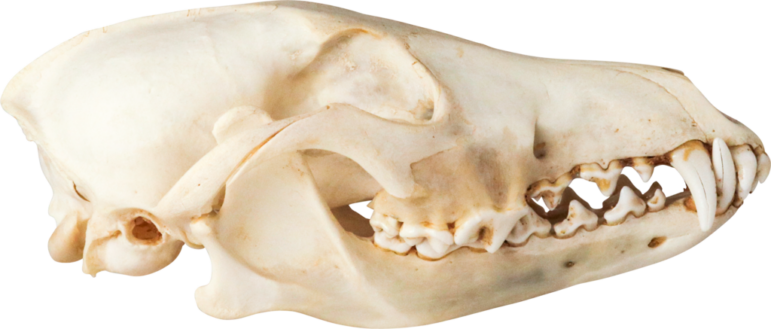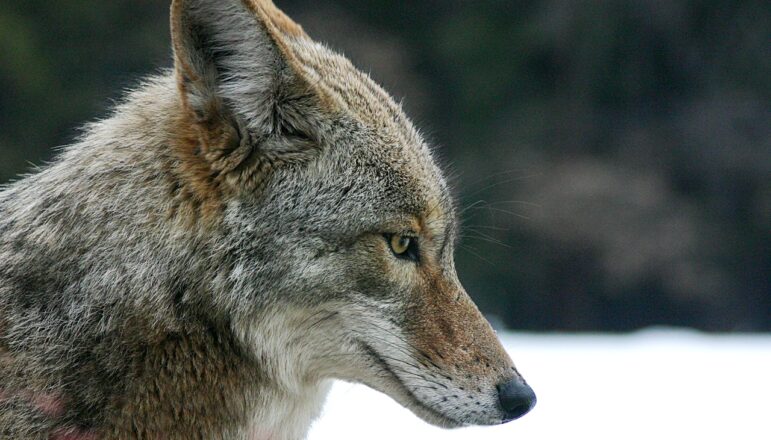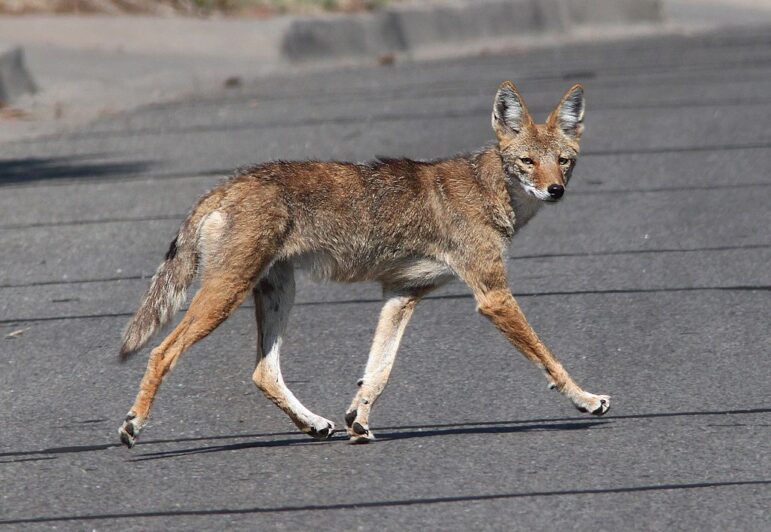
The first time I bought a coyote skin, it was just a small one – just the face, pulled out of a bin of fur bits and oddments at the Renaissance Faire. My friends and I had driven all day to get there and, loopy from sleep deprivation and allergy meds, we each got something from that stall with its vague barbarian theme. We spent the rest of the day trying to figure out how to accessorize our thrift store costumes with fur and bone, running wild across the dirt paths of an imaginary town. When we finally started the drive home, my coyote rode on my knee. I pet the edge of his ruff the way I would pet a dog, both of us tired from an exciting day.
Even then, coyotes were important to me. As a kid, living in the country, I heard them more than I saw them, whole packs singing off in the fields. Like anything that a child can’t get a good look at, they were eldritch and wonderful and terrifying, constantly unexpected when they did appear at the edge of town or off in the distance. I loved hearing them just as much as I was superstitiously afraid that, someday, I would be wandering alone and get eaten by a pack like people got eaten by wolves in books. By the time I was a little older the fear had faded into a deep and respectful fondness, a kind of yearning I didn’t yet have words for.
That piece of pelt, my coyote face, kept me company through college by joining the few stuffed animals that had come with me on my journey into adulthood. When I moved out of the dorm they drifted into storage – one of the great plastic bins that I was using instead of moving boxes, in those days. I was fond of it, but what could I do with a piece of fur no larger than my two hands together, neither decoration nor accessory?
When I put up my first altar, I had my answer. The altar itself was a small wooden table, the kind used for TV trays or card games, covered with a goat skin that I had left over from a halloween costume. There were very few things on it – a wooden slat to burn incense on, a brass container, a statue that was more expensive that I could afford, and my coyote. After all, I thought – the archetype I was most interested in was the trickster. Coyote was certainly one of those – and I loved the few stories that I knew about him. Anyone who gave fire to humans was a friend of mine.
It took me a while to realize this was not exactly true.

A coyote skull [TylerMascola, Wikimedia Commons, public domain]
The skull is what started me wondering. It was a gift, originally – one of my friends who knew more about vulture culture had found it at a decent price and sent it shortly after I moved to my own place. “You need decorations,” they said. Delighted, I dedicated it straight away, putting it on the altar next to the pelt. I wasn’t yet thinking about spirits as people, exactly – these were things that reminded me of a set of stories I didn’t know well but was fond of, nothing more. That is, until the skull started to rot.
I later learned that this is fairly common, especially with home-cleaned bones. There are sinuses in a skull that, given less than a perfect treatment, will harbor tissue still and discolor the bone. If I had done a little research, it would have been a simple matter to fix. Instead, I stuck it in vinegar. Then, in hydrogen peroxide. Then, as it was falling apart along its seams, ruined by the chemicals but still discolored with rot, I stuck it in the freezer – and there it stayed until I moved and, despairing, threw it out.
I had been thinking in archetypes when the long process started, but by the time I admitted defeat I had a more active practice with spirits of various kinds – and I could tell a sign when I saw one. Still, I ignored it for as long as I could. I was deeply fond of Coyote, and I was stubborn as a mule. My growing discomfort with how little I really knew about him, my building worries about appropriation, and the incredibly literal difficulty with keeping him on my altar aside, I didn’t want to take him out of my practice. It took a while – longer than I’m proud of – to try any divination on the matter. Then I took my tiny pelt and packed it up again, back into the bin with winter coats and family albums and other things I didn’t quite have a place for.

A coyote in Yosemite National Park, California, USA [Christopher Bruno, Wikimedia Commons, CC 3.0]
There’s no way for me to talk about living in America, about the animals and birds that contextualize my life, without bringing race into it. I am, as verified by DNA tests, astoundingly white. My family has been here for hundreds of years and I still clock in at over 40% British. There’s discomfort in that, for me. My home has always been in the Midwest, with our vast landscapes of farmland. It’s not land that I should be on. I knew the red-winged blackbird and the cardinal as my first birds. To this day, I don’t know if there are stories about them that the Native American tribes who live here tell to their children.
Working with Coyote, the trickster figure that flits across and through the stories of so many Indigenous mythologies, was appropriative of me. They weren’t my stories to tell. He wasn’t a spirit that I knew how to work with. But stepping away from him didn’t lessen how deeply I related to the coyotes that lived around and with me, or how important they were to my practice. Living in the city, I started to appreciate how clever and adaptable they were. There were days when I, also a country beast making a home away from the fields, deeply identified with it. One evening, in the twilight of a tree-lined street, I found myself walking alongside one. He seemed impossibly big, a figure out of a story, and we regarded each other with interest as he went about his way – neighbors nodding on a stroll. It was a moment that felt significant, heavy with import as it landed in my gut – but for the life of me, I couldn’t figure out what meaning to make of it.
I tried out different models, trying on labels like hats. I read Lupa’s books for ways that others have navigated similar connections. I bought books about coyote biology and history, watched videos of them on trains, wore t-shirts and bought art and tried to make up a word that would explain how and why they are so important to me.

Coyote strolling [Alan Schmierer, Wikimedia Commons, public domain]
I think it’s fitting that these rangy, far-ranging canines have evaded every attempt I’ve made to pin them down. No word I could find fit the way they showed up for me. No attempt I made solidified my practice around them. Eventually, at long last, I gave up. “I just like them,” I said to myself. “Sometimes you like an animal. Not everything has to be laden with mystic significance. Calm down.”
The next day, I opened a package from my friend, and a coyote pelt came out. Four feet from tail to snout, she’s big enough to lay across a chair or wrap around my shoulders. “She can’t live with me anymore,” my friend said. “I thought you’d give her a better home.”
She is laying across my lap as I write this, pausing occasionally to scritch the thick fur of her ruff. “I love her,” I tell my friend. “I’m sure we’ll get along just fine.”
The Wild Hunt is not responsible for links to external content.
To join a conversation on this post:
Visit our The Wild Hunt subreddit! Point your favorite browser to https://www.reddit.com/r/The_Wild_Hunt_News/, then click “JOIN”. Make sure to click the bell, too, to be notified of new articles posted to our subreddit.